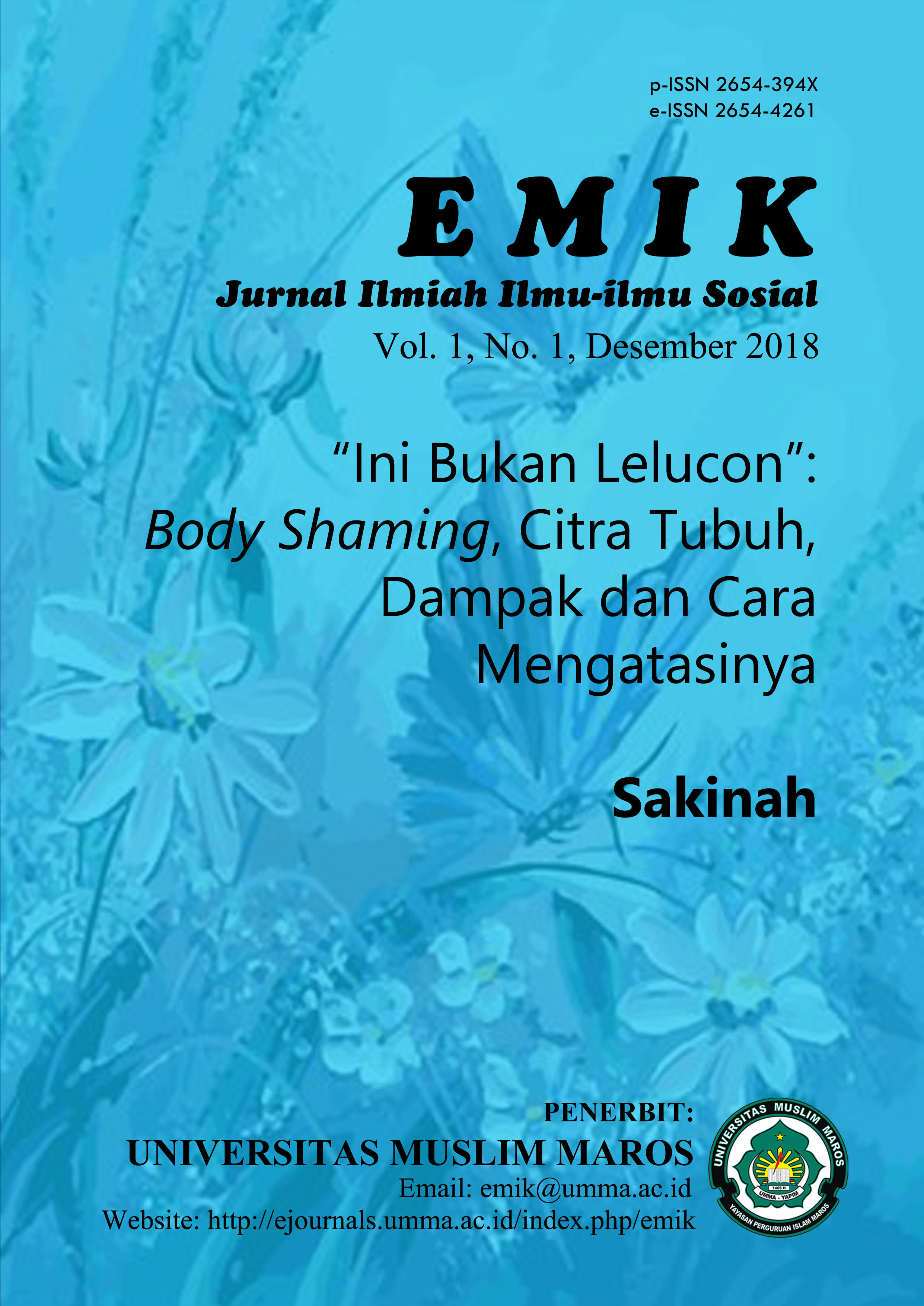“Ini Bukan Lelucon”
Body Shaming, Citra Tubuh, Dampak dan Cara Mengatasinya
Keywords:
Values, Ideal Bodies, Ideal Standards, Body Image, Body ShamingAbstract
Technological advances have an impact on the spread of values that influence people's perspectives and attitudes towards something, including the standarization of an ideal body. Thi ideal standard then shape one's self perception in the eyes of others and when the ideal standard is not met, it may cause body shame. Nowadays, physical appearance that is considered not ideal is also often used as a joke or ridicule, known as body shaming. Although by way of joking, body shaming can be categorized as an act of bullying since it is considered as verbal and non-verbal violence. This article will discuss self body image in connection with one’s self acceptance, the forms of body shaming, the impact of body shaming, and how one deals with body shaming. The study was conducted through social media, namely Instagram. It involved eleven informants who had experienced body shaming. The data collection techniques are carried out through interviews and observations. The study indicates that body image is associated with body proportion, skin colour, condition of face skin, tooth and hair shape. When one’s body is not met social standard, the participants tend to face body shaming which can be through bad words (i.e. looks like Mrs. Puff, thin as a board, etc.), actions (i.e. cynical attitude, broken up by boyfriend, difficult to get a job, etc.). This impacted on one’s self confidence and a sense of insecurity, their effort to do anything to meet social expectation, including gaining/loosing weight, accepting themselves as the way they are, thinking positively, and getting away from people who often do body shaming. It is argued in this article that one’s physical performance can be socially controlled depending on one’s self acceptance.
References
Cash, T. F. dan Pruzinsky, T. 2002. “Future Challenges for Body Image Theory, Research, and Clinical Practice. In T. F. Cash dan T. Pruzinsky (eds.), Body image: A Handbook of Theory, Research, and ClinicalPpractice. New York: Guilford Press, 509-516.
Chairiah, P. 2012. Hubungan Gambaran Body Image Dan Pola Makan Remaja Putri Di SMAN 38 Jakarta. Skripsi, Fakultas Ilmu Keperawatan Universitas Indonesia, Depok.
Damanik, T. M. 2018. Dinamika Psikologis Perempuan Mengalami Body shaming. Skripsi, Program Studi Psikologi Fakultas Psikologi Universitas Sanata Dharma, Yogyakarta.
Grogan, S. 1999. Body Image: Understanding Body Dissatisfaction in Men, Women and Children. London: Routledge.
Hasmalawati, N. 2017. “Pengaruh Citra Tubuh dan Perilaku Makan Terhadap Penerimaan Diri Pada Wanita. Jurnal Psikoislamedia, 2(2):107-115.
Muth, J. L. dan Cash, T. F. 1997. “Body Image Attitudes: What Difference Does Gender Make?”. Journal of Applied Social Psychology. 27 (16):1438-1452.
Nurvita, V. dan Handayani, M.M. 2015. “Hubungan Antara Self-esteem dengan Body Image pada Remaja Awal yang Mengalami Obesitas”. Jurnal Psikologi Klinis dan Kesehatan Mental, 4(1):41-49.
Sa'diyah, H. 2015. Pengaruh Citra Tubuh Terhadap Penyesuaian Diri Siswa-Siswi Kelas VII-VIII SMP NU Syamsuddin Malang. Tesis, UIN Maulana Malik Ibrahim, Malang.
Seawell, A.H. dan Danoff-Burg, S. (2005). “Body Image and Sexuality in Women with and Without Systemic Lupus Erythematosus”. Sex Roles, 53 (11): 865-876.
Widiasti, Ni Luh R. 2016. Profil Citra Tubuh (Body Image) Pada Remaja dan Implikasinya Bagi Bimbingan dan Konseling. Skripsi, Departemen Psikologi Pendidikan dan Bimbingan FIP Universitas Pendidikan Indonesia, Bandung.
Vialini, Greytha. 2014. Pemaknaan Tubuh Ideal: Studi Deskriptif Tentang Pemaknaan Tubuh Ideal Bagi Komunitas XL’SO). Skripsi, Departemen Sosiologi FISIP Universitas Airlangga, Surabaya.










9.png)















